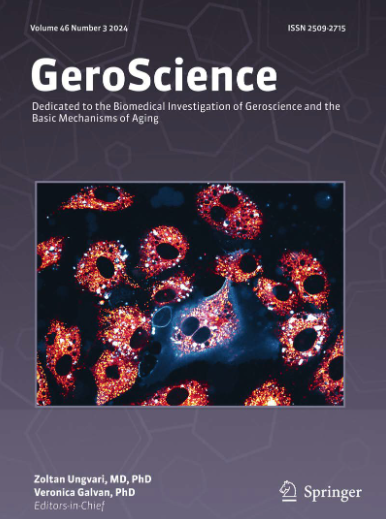proBNPage减少(PBAR)试验-一项随机、双盲、安慰剂对照的试点研究结果,以微调基于nt - probnp的方法来评估抗衰老治疗的效果。
IF 5.4
2区 医学
Q1 GERIATRICS & GERONTOLOGY
引用次数: 0
摘要
NT-proBNP水平随年龄呈指数增长,并与心血管和全因死亡率相关。从NT-proBNP浓度中可以获得生物年龄的替代品(“proBNPage”)。本研究的主要目的是确定一种方法来设计使用proBNPage进行抗衰老治疗的未来试验。第二个目的是对4种潜在的抗衰老膳食补充剂进行初步评估。试验为期2年,纳入120名年龄为71.7±4.6岁的健康受试者,分为3组:A)辅酶Q10 100 mg bid +硒100 mcg, B)白藜芦醇350 mg bid + TA-65 100U, C)安慰剂。ProBNPage是主要结局变量。次要变量包括台阶测试持续时间、握力和自我报告的健康状况。在B组,由于ldl -胆固醇明显升高,研究在第5个月中断,这可能是由高剂量白藜芦醇引起的。部分由于退学和治疗摄入不足,A组和C组在主要和次要变量上没有显着差异。因此,这些组被认为是一个单一的组,其中2年后proBNPage增加2.5年(P = 0.01),特别是70岁以上的受试者(+ 3.0年,P = 0.009)。因此,计算出126名70岁以上的受试者可以允许评估2年治疗与安慰剂的功率为80%。本研究开发了一种基于nt - probnp的方法来评估未来对生物年龄的干预措施。这些处理没有引起proBNPage的显著变化。B组胆固醇显著升高表明应避免使用高剂量白藜芦醇。本文章由计算机程序翻译,如有差异,请以英文原文为准。
The proBNPage reduction (PBAR) trial-results of a randomized, double blind, placebo-controlled, pilot study to fine tune an NT-proBNP-based method to assess the effect of anti-aging treatments.
NT-proBNP levels increase exponentially with age and are associated with cardiovascular and all-cause mortality. From NT-proBNP concentration a surrogate for biological age ("proBNPage") can be obtained. The primary objective of this study was to define a method to design future trials on anti-aging treatments using proBNPage. The secondary objective was the tentative evaluation of 4 potential anti-aging dietary supplements. The trial lasted 2 years and involved 120 healthy subjects aged 71.7 ± 4.6 years divided into 3 groups: A) coenzyme Q10 100 mg bid + selenium 100 mcg, B) resveratrol 350 mg bid + TA-65 100U, C) placebo. ProBNPage was the primary outcome variable. Secondary variables included step test duration, handgrip strength, and self-reported health status. In group B, the study was interrupted at month 5 due to significant LDL-cholesterol increase, probably caused by the high-dose resveratrol. Partly because of dropouts and inadequate treatment intake, groups A and C showed non-significant differences in the primary and secondary variables. Therefore, these groups were considered a single group, in which after 2 years proBNPage increased by 2.5 years (P = 0.01), particularly in subjects over 70 (+ 3.0 years, P = 0.009). It was thus calculated that 126 subjects over 70 could allow the assessment of a 2-year treatment vs. placebo with a power of 80%. This study has developed an NT-proBNP-based method to evaluate future interventions on biological age. The treatments did not induce significant changes in proBNPage. The marked increase in cholesterol in group B suggests that high-dose resveratrol should be avoided.
求助全文
通过发布文献求助,成功后即可免费获取论文全文。
去求助
来源期刊

GeroScience
Medicine-Complementary and Alternative Medicine
CiteScore
10.50
自引率
5.40%
发文量
182
期刊介绍:
GeroScience is a bi-monthly, international, peer-reviewed journal that publishes articles related to research in the biology of aging and research on biomedical applications that impact aging. The scope of articles to be considered include evolutionary biology, biophysics, genetics, genomics, proteomics, molecular biology, cell biology, biochemistry, endocrinology, immunology, physiology, pharmacology, neuroscience, and psychology.
 求助内容:
求助内容: 应助结果提醒方式:
应助结果提醒方式:


